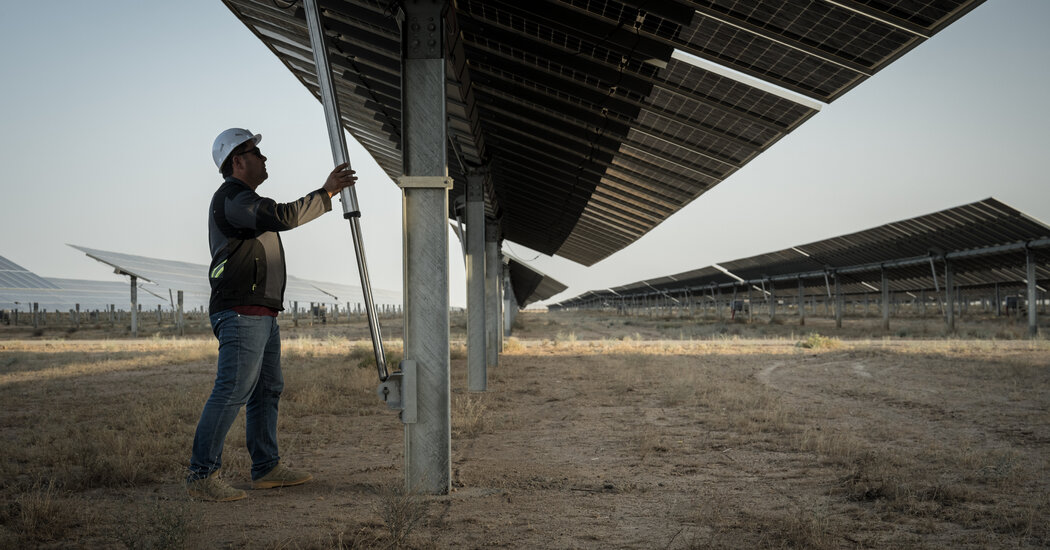It’s officially climate summit season. Starting on Sunday in New York, policymakers, diplomats and many others will convene for Climate Week, along with the U.N. General Assembly and several related gatherings, including our own Climate Forward event.
And COP, the annual U.N.-sponsored climate meeting, is just a couple months away. Each year, the talks get more urgent as the world struggles to wean itself from planet-warming fossil fuels.
Adding to the tension, this year’s COP talks are being held in the United Arab Emirates, where the national energy company recently said it plans to spend $150 billion over the next five years, mostly to ramp up fossil fuel production.
And the guy who runs the Emirates’ national oil company? He’s in charge of the climate talks and he says he’s perfect for the job.
This year’s COP president, Sultan al-Jaber, hasn’t given a lot of interviews. So, to get one, I traveled all the way to Uzbekistan.
Not because he happened to be there, but because companies he is linked to are investing big money to modernize the country’s energy infrastructure. Uzbekistan is a developing country facing many of the issues that will be on display at Climate Week and COP.
The Emirates wants to be seen as a climate-friendly renewable energy superpower, plowing billions into wind and solar in places like Uzbekistan even as it helps lock those same developing nations into decades of fossil fuel production through its other investments.
In our interview, Al-Jaber told me his position in both the renewable energy and fossil fuels worlds gave him a unique vantage point for the annual global climate negotiations. He argues that progress has been stymied because climate advocates and fossil fuel interests vilified each other, a problem he’d solve by bringing them to the same negotiating table.
He could probably claim seats on both sides of that table: He runs Masdar, a renewable company that funds zero-emissions energy technologies like wind and solar power across 40 countries. And he’s also the head of Adnoc, one of the world’s biggest oil companies. He told me it would keep producing more fossil fuels “as long as the market demands it.”
At the center of it all
Clean energy investments by Masdar could help Uzbekistan, a vast, landlocked country in Central Asia where the population and its energy needs are growing rapidly, rely less on the fossil fuels that make up nearly all of its energy arsenal today.
Its government relies entirely on foreign funding to build up its energy infrastructure, however, and will take what it can get. That means wind and solar farms from Masdar, but also new gas plants financed by two other U.A.E. state-run companies, TAQA and Mubadala. (Those two companies, along with Adnoc, are also part owners of Masdar).
Al-Jaber is at the center of it all. He said he hoped to get countries to agree on a tripling of global renewable energy capacity at the climate talks. Emirati funding of both renewable and fossil energy is playing out elsewhere, too. In Azerbaijan, a recent Adnoc investment in an offshore oil field overshadowed Masdar’s expansion in renewable energy.
Adnoc’s projected investments will lead to more than 2.7 gigatons of carbon dioxide emissions, according to a 2022 report from Oil Change International. That is equivalent to more than a year of combined emissions from Germany and Japan, and is second in scope only to Qatar’s national energy company, which is building the world’s largest gas facility.
‘Everything we can get’
Uzbekistan is opening up its economy under a relatively new president, only the second since the Soviet Union fell and Uzbekistan got its independence. The first was a renowned dictator.
The government officials I spoke to in Tashkent, Uzbekistan’s capital, lavished praise on Masdar for offering to build renewable energy and sell it to the national grid at a rate cheaper than gas. But they still wanted gas investment, too.
“We want whatever can be done quickest and cheapest,” Jurabek Mirzamakhmudov, the energy minister, told me.
He said he’d like to get secure more investment in renewables from Masdar, but to help his economy he would happily take money from Masdar’s fossil fuel-rich owners, too.
“I’m doing everything I can,” Mirzamakhmudov said, grimacing.
Electric vehicles and the auto strike
At midnight tonight, 150,000 autoworkers at General Motors, Ford and Stellantis, the parent of Chrysler, could go on strike.
There would be far-reaching implications for the economy, with many issues at play. And there is one element that will have a big impact on the transition to clean energy: How the automakers and unions handle the accelerating shift to electric vehicles.
The Big Three automakers are spending tens of billions of dollars investing in new E.V. production lines and battery factories as they jockey for market share in the fastest-growing segment of the industry. Those investments, the companies say, limit how much additional compensation they can offer workers.
A related thorny question: How many workers will be needed in an auto industry dominated by E.V.s, and will they be part of a union? Generally, it takes fewer assembly-line workers to construct an electric vehicle than a combustion-driven car or truck. Battery factories are booming, but many are nonunion joint ventures that aren’t covered by the U.A.W.’s contract.
Then, there is Tesla. Elon Musk’s nonunion company is already the largest producer of E.V.s in the United States, and it currently produces those cars much more profitably than Ford, G.M. or Chrysler. Tesla has also been slashing prices as it seeks to keep the pressure on its rivals.
There are no easy answers, and both the automakers and their unions are uneasy about the disruption and changes to come. — David Gelles











